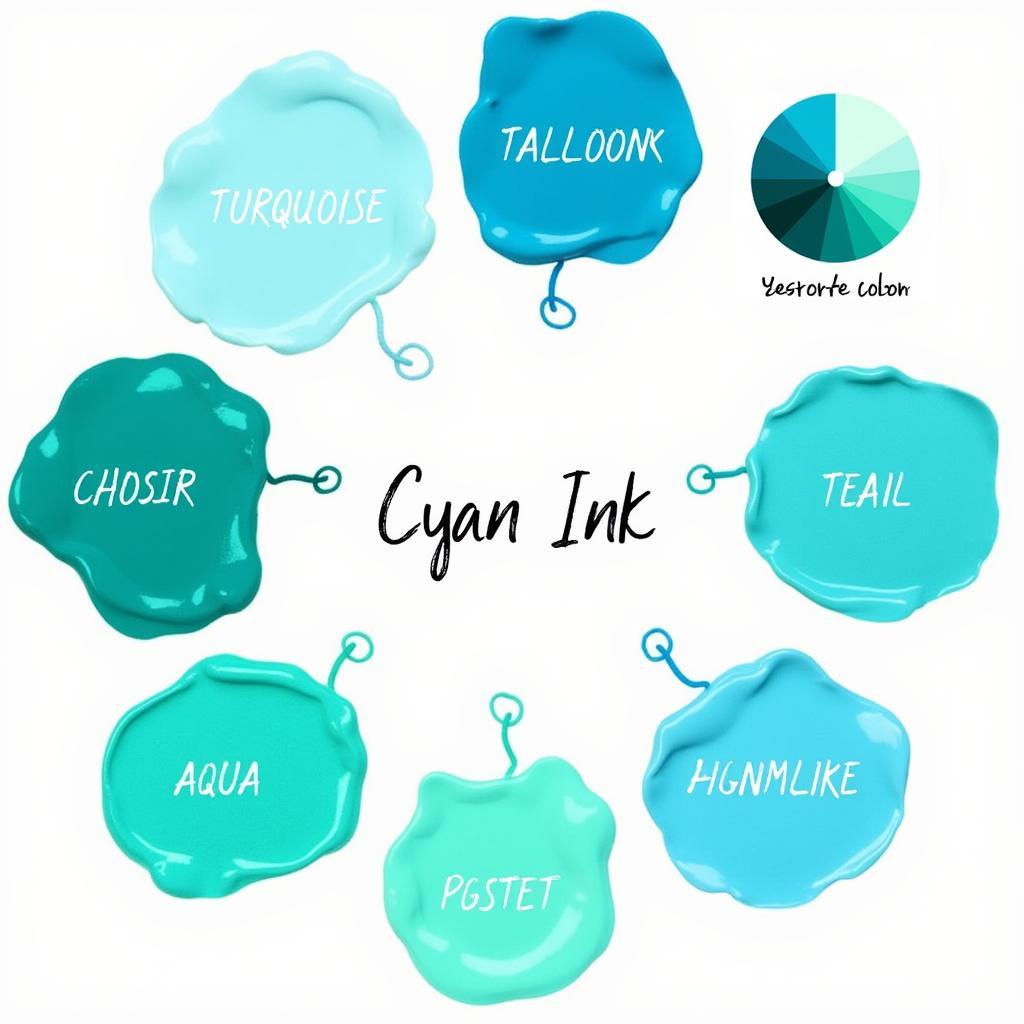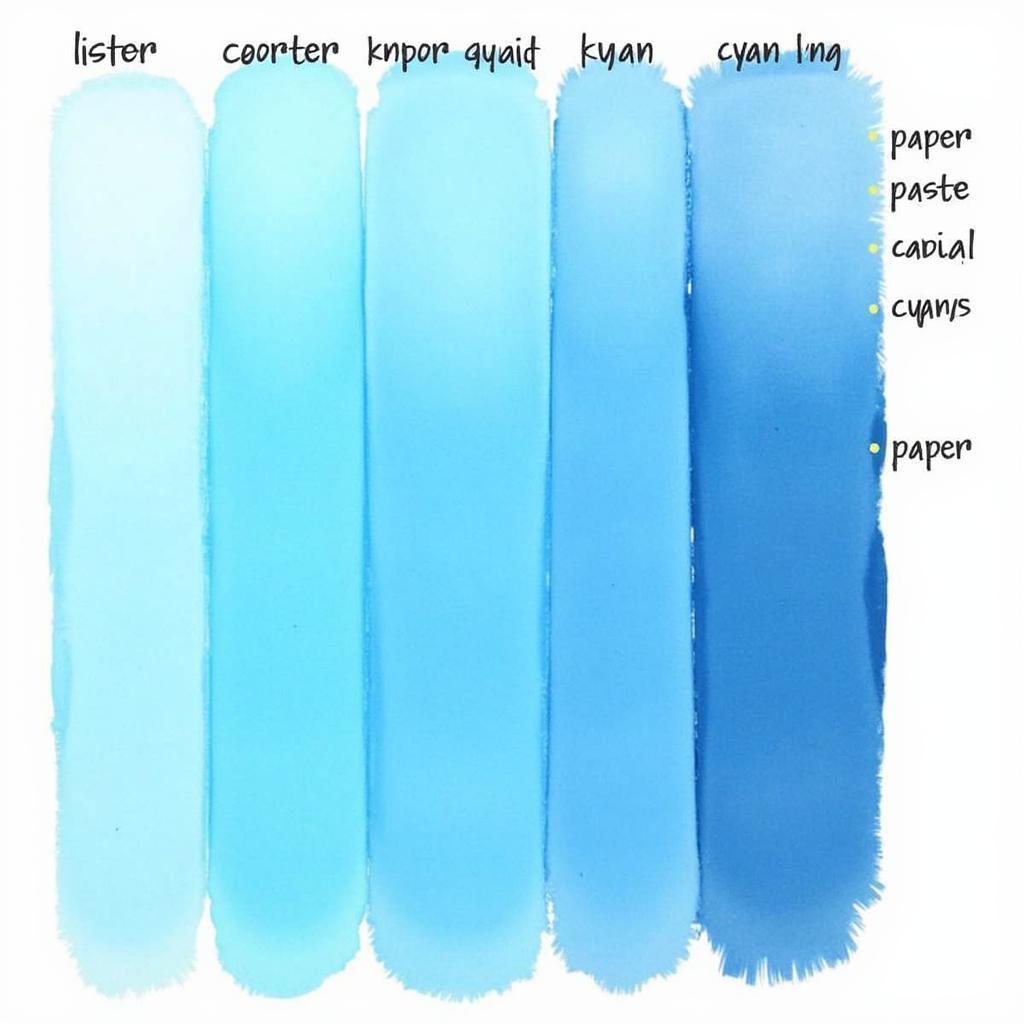Cyan ink is a vibrant, greenish-blue color, one of the primary colors used in subtractive color mixing. It plays a crucial role in printing, particularly in the CMYK color model. Understanding what exactly cyan is and how it interacts with other colors is essential for anyone working with ink, whether you’re a professional printer or simply refilling your home printer.  Cyan Ink Color Comparison with Other Blues and Greens
Cyan Ink Color Comparison with Other Blues and Greens
Understanding the Science Behind Cyan Ink
Cyan, alongside magenta and yellow, forms the foundation of the CMYK color model used in most printing processes. Unlike additive color mixing (RGB) used in screens, which combines light to create colors, subtractive color mixing works by absorbing specific wavelengths of light. When white light hits a cyan-colored surface, the surface absorbs the red wavelengths, reflecting back the blue and green light, which our eyes perceive as cyan. This is why cyan is considered the “opposite” or “complementary” color of red.
Cyan in the CMYK Color Model
In CMYK, the “C” stands for cyan. By combining cyan, magenta, and yellow inks in varying proportions, a wide range of colors can be produced. Adding black (K) enhances the depth and contrast of darker shades. If you are curious about other color combinations, learn how to get purple color. The absence of all inks results in white, while the combination of all inks ideally results in black, although in practice, it often appears as a dark brown.
Different Shades and Variations of Cyan Ink
While we often talk about cyan as a single color, there are actually several variations. These subtle differences can be attributed to the specific pigments used in the ink formulation. Factors such as the ink’s manufacturer, intended use (e.g., for photography, graphic design, or general printing), and even the type of paper it’s printed on can influence the final color.  Different Shades and Variations of Cyan Ink Knowing the subtle nuances of what colors make up black helps us appreciate the complexities of color mixing.
Different Shades and Variations of Cyan Ink Knowing the subtle nuances of what colors make up black helps us appreciate the complexities of color mixing.
Process Cyan vs. Spot Color Cyan
In printing, we distinguish between “process cyan” and “spot color cyan.” Process cyan is the standard cyan ink used in CMYK printing. Spot color cyan, on the other hand, is a pre-mixed ink with a specific Pantone number, ensuring color consistency across different print runs.
What Does Cyan Ink Look Like in Real-World Applications?
Cyan ink’s vibrant hue makes it a popular choice in a variety of applications, from packaging and branding to fine art prints and illustrations. Its cool tone can evoke feelings of tranquility and freshness, making it a suitable choice for designs related to water, nature, or technology. Consider is leaves changing color a chemical or physical change to understand the fascinating science behind color transformations in nature.
Why is Understanding Cyan Important for Design and Printing?
A thorough understanding of cyan ink is crucial for designers and printers alike. It allows for accurate color reproduction and predictable results. Knowing how cyan interacts with other inks in the CMYK model is essential for achieving the desired color outcome in printed materials.
“Cyan is a powerful color that can add a dynamic element to any design. Its vibrancy and versatility make it a valuable tool for any artist or designer,” says renowned color consultant, Anya Sharma.
Common Questions About Cyan Ink
Is cyan ink the same as turquoise? While similar, cyan is generally a purer, more greenish-blue, while turquoise often has more green or blue undertones.
What is the hex code for cyan ink? The most common hex code for cyan is #00FFFF.
How do I mix cyan ink? Cyan is a primary color in the subtractive model, so it can’t be mixed from other inks. However, you can achieve similar shades by blending blue and green. If you are interested in other unique egg colors, you can explore what chicken lays colored eggs.
“Knowing how to use cyan effectively can make all the difference in achieving vibrant and accurate color representation in your print projects,” adds graphic designer, Marco Rossi.
In conclusion, cyan ink is a crucial component of the printing process. Understanding its properties and how it interacts with other colors is essential for achieving accurate and vibrant results in your printed materials. What color is cyan ink? It’s a vibrant greenish-blue that brings life to your designs.
FAQ
What is the difference between cyan and aqua?
How can I achieve different shades of cyan in my printing?
Why is cyan used in the CMYK color model?
What are some common uses of cyan ink in design?
If you’re looking for answers about the color of the inside of your mouth, check out our article on what color is the roof of your mouth.
Need help with your next color project? Contact us at 0373298888, email [email protected], or visit us at 86 Cầu Giấy, Hà Nội. Our 24/7 customer service team is ready to assist you.
